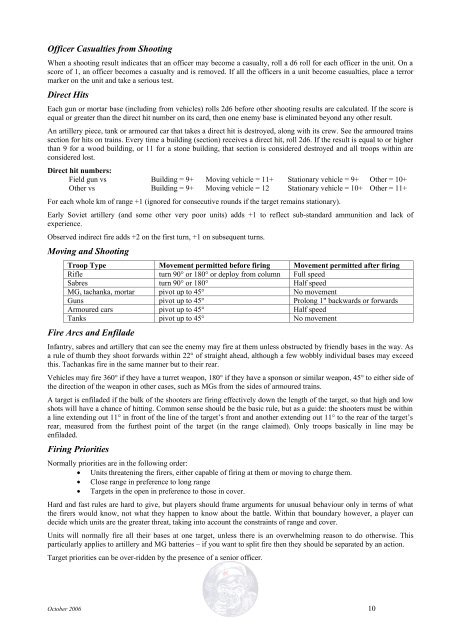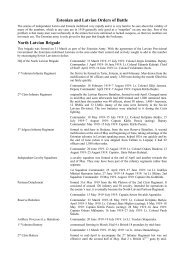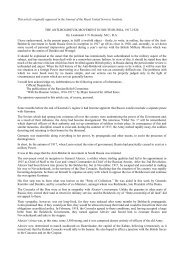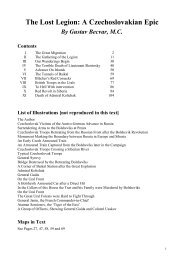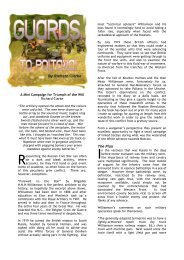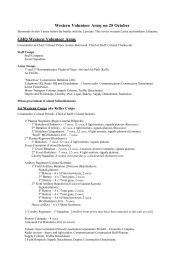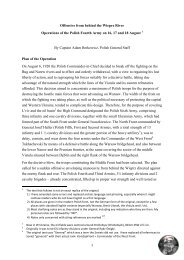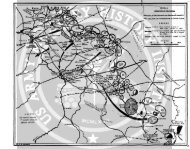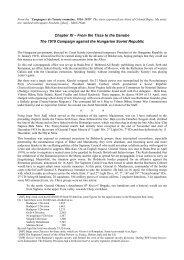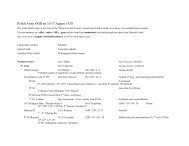You also want an ePaper? Increase the reach of your titles
YUMPU automatically turns print PDFs into web optimized ePapers that Google loves.
Officer Casualties from Shooting<br />
When a shooting result indicates that an officer may become a casualty, roll a d6 roll for each officer in the unit. On a<br />
score of 1, an officer becomes a casualty and is removed. If all the officers in a unit become casualties, place a terror<br />
marker on the unit and take a serious test.<br />
Direct Hits<br />
Each gun or mortar base (including from vehicles) rolls 2d6 before other shooting results are calculated. If the score is<br />
equal or greater than the direct hit number on its card, then one enemy base is eliminated beyond any other result.<br />
An artillery piece, tank or armoured car that takes a direct hit is destroyed, along with its crew. See the armoured trains<br />
section for hits on trains. Every time a building (section) receives a direct hit, roll 2d6. If the result is equal to or higher<br />
than 9 for a wood building, or 11 for a stone building, that section is considered destroyed and all troops within are<br />
considered lost.<br />
Direct hit numbers:<br />
Field gun vs Building = 9+ Moving vehicle = 11+ Stationary vehicle = 9+ Other = 10+<br />
Other vs Building = 9+ Moving vehicle = 12 Stationary vehicle = 10+ Other = 11+<br />
For each whole km of range +1 (ignored for consecutive rounds if the target remains stationary).<br />
Early Soviet artillery (and some other very poor units) adds +1 to reflect sub-standard ammunition and lack of<br />
experience.<br />
Observed indirect fire adds +2 on the first turn, +1 on subsequent turns.<br />
Moving and Shooting<br />
Troop Type Movement permitted before firing Movement permitted after firing<br />
Rifle turn 90° or 180° or deploy from column Full speed<br />
Sabres turn 90° or 180° Half speed<br />
MG, tachanka, mortar pivot up to 45° No movement<br />
Guns pivot up to 45° Prolong 1" backwards or forwards<br />
Armoured cars pivot up to 45° Half speed<br />
Tanks pivot up to 45° No movement<br />
Fire Arcs and Enfilade<br />
Infantry, sabres and artillery that can see the enemy may fire at them unless obstructed by friendly bases in the way. As<br />
a rule of thumb they shoot forwards within 22° of straight ahead, although a few wobbly individual bases may exceed<br />
this. Tachankas fire in the same manner but to their rear.<br />
Vehicles may fire 360° if they have a turret weapon, 180° if they have a sponson or similar weapon, 45° to either side of<br />
the direction of the weapon in other cases, such as MGs from the sides of armoured trains.<br />
A target is enfiladed if the bulk of the shooters are firing effectively down the length of the target, so that high and low<br />
shots will have a chance of hitting. Common sense should be the basic rule, but as a guide: the shooters must be within<br />
a line extending out 11° in front of the line of the target’s front and another extending out 11° to the rear of the target’s<br />
rear, measured from the furthest point of the target (in the range claimed). Only troops basically in line may be<br />
enfiladed.<br />
Firing Priorities<br />
Normally priorities are in the following order:<br />
• Units threatening the firers, either capable of firing at them or moving to charge them.<br />
• Close range in preference to long range<br />
• Targets in the open in preference to those in cover.<br />
Hard and fast rules are hard to give, but players should frame arguments for unusual behaviour only in terms of what<br />
the firers would know, not what they happen to know about the battle. Within that boundary however, a player can<br />
decide which units are the greater threat, taking into account the constraints of range and cover.<br />
Units will normally fire all their bases at one target, unless there is an overwhelming reason to do otherwise. This<br />
particularly applies to artillery and MG batteries – if you want to split fire then they should be separated by an action.<br />
Target priorities can be over-ridden by the presence of a senior officer.<br />
October 2006 10


